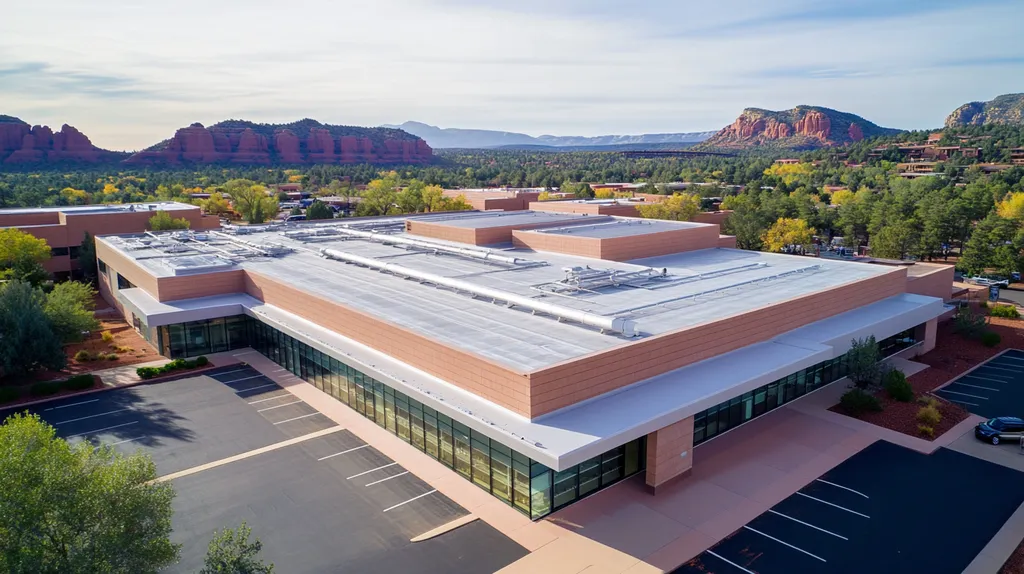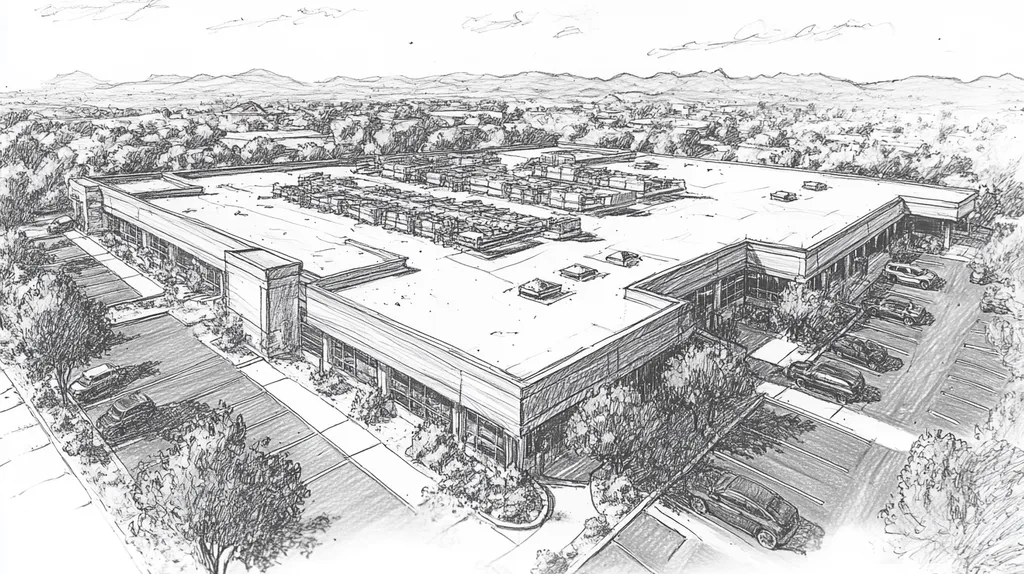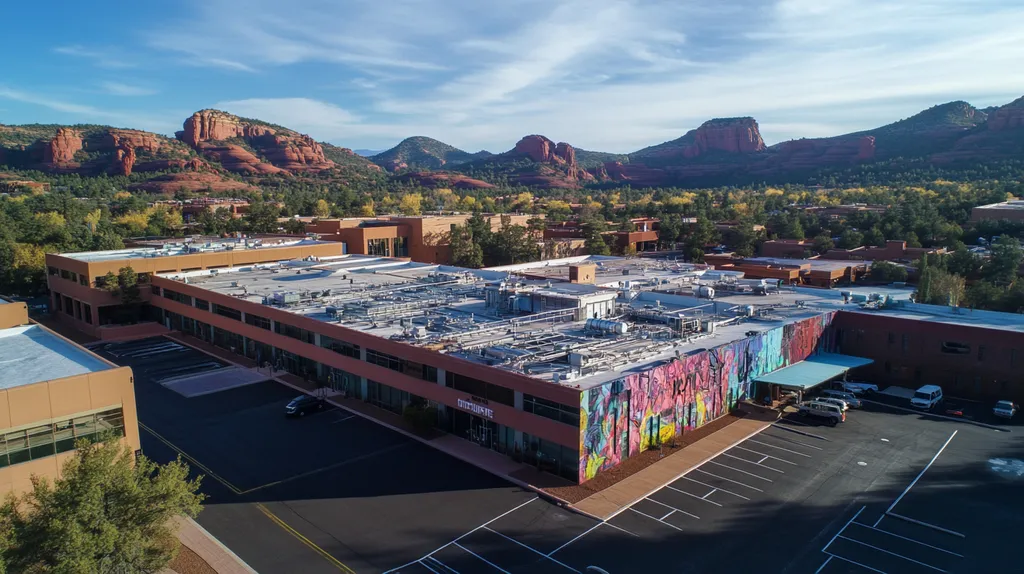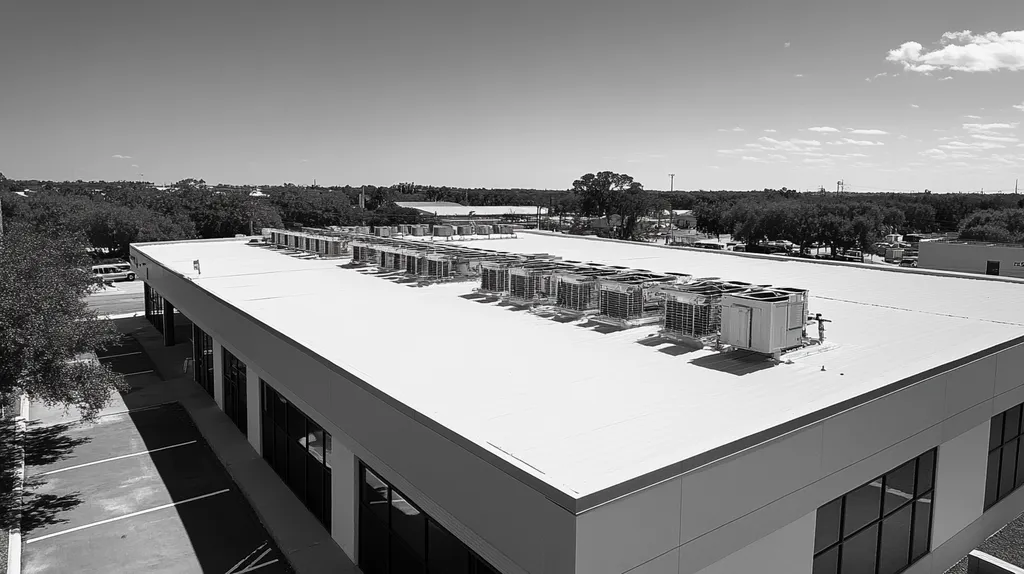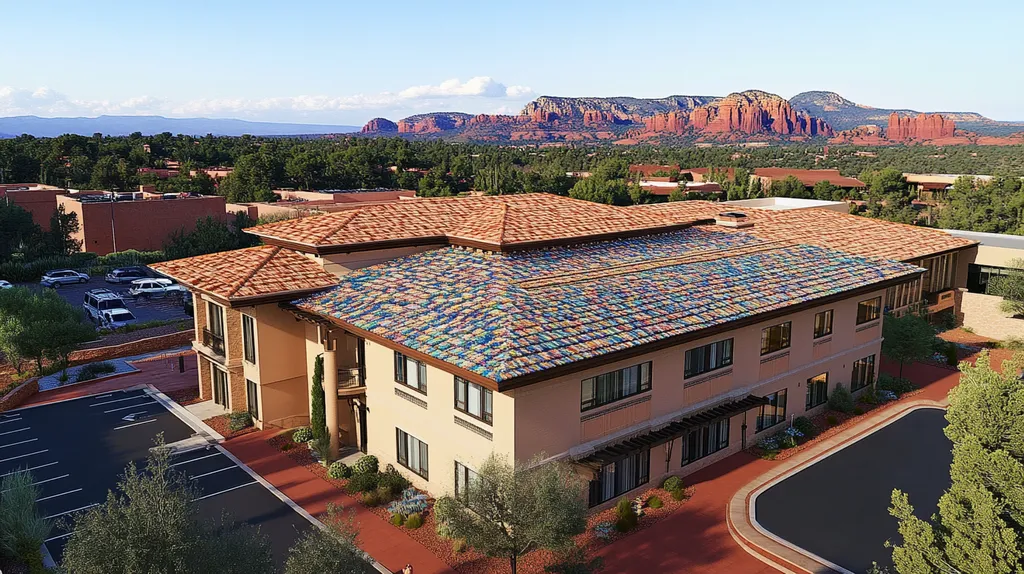Welcome to today’s Battle Royale featuring two roofing heavyweights: “TPO” in the east corner versus “PVC” in the west!
Tonight’s showdown pits these contenders against each other across six punishing rounds designed to test every aspect of their performance for Commercial Roof Materials for Varying Climates.
At stake? Millions in potential costs, decades of building protection, and the critical performance demands of modern commercial and industrial facilities.
Our professional judging panel will evaluate each round on technical merit, real-world performance, and value delivery. After all six rounds, we’ll declare our ultimate champion.
Ladies and gentlemen, facility managers and building owners… it’s time to rumble!
ROUND 1: INITIAL COSTS & INSTALLATION
When selecting commercial roofing materials, initial costs and installation considerations can make or break a project’s success. Single-ply membrane roofing typically costs between $5 and $9.50 per square foot installed, with a 20,000-square-foot commercial project ranging from $100,000 to $190,000. Making the wrong choice between TPO and PVC can lead to unnecessary expenses and extended installation timelines. (source: GM Exteriors)
Material Expenses
Material costs represent a significant portion of any commercial roofing project’s budget. TPO membranes typically cost 20-30% less than comparable PVC materials, making them an attractive option for cost-conscious property owners.
TPO’s lower price point stems from simpler manufacturing processes and more readily available raw materials. This cost advantage becomes particularly significant on larger commercial projects where material expenses can quickly escalate.
PVC membranes command premium pricing due to their more complex chemical composition and manufacturing requirements. While this higher cost often correlates with enhanced durability, it can strain initial project budgets.
For material expenses, TPO holds a clear ADVANTAGE due to its lower cost per square foot without sacrificing essential performance characteristics.
Installation Complexity
Installation complexity directly impacts labor costs and project duration. TPO installation follows straightforward processes with fewer specialized requirements, allowing for efficient deployment across large roof surfaces.
TPO’s lighter weight and flexible nature make it easier for roofing crews to maneuver and position. The material’s weldability at the seams requires standard heat-welding equipment, reducing specialized tool requirements.
PVC installation demands more technical expertise and specialized equipment. Its slightly stiffer composition can make it more challenging to work with, particularly around roof penetrations and complex geometries.
Considering installation complexity factors, TPO gains the ADVANTAGE through its more straightforward installation requirements.
Project Timeline
Project duration affects both direct costs and business disruption. TPO installations typically progress faster due to simplified handling and fewer specialized installation steps.
The speed advantage of TPO becomes particularly evident in larger projects. Crews can cover more square footage per day compared to PVC, reducing overall installation time.
PVC installations generally require more time due to additional preparation steps and more complex detail work. This extended timeline can increase labor costs and prolong business disruption.
In the project timeline category, TPO earns another ADVANTAGE through faster installation rates and reduced complexity.
ROUND 1 WINNER: TPO
ROUND 2: DURABILITY & LIFESPAN
When evaluating commercial roofing materials, durability and lifespan directly impact long-term facility costs and operational continuity. A roof failure can cost businesses up to $500,000 in damages and lost revenue, making material selection crucial. Understanding how TPO and PVC perform across different weather conditions, expected lifespans, and maintenance requirements helps prevent costly mistakes.
Weather Resistance
TPO roofing systems demonstrate strong resistance to UV radiation and heat, with their white surfaces reflecting up to 85% of solar energy. These membranes maintain flexibility in moderate temperatures but can show stress at extremes below 0°F or above 160°F.
The material offers good resistance to tears and impacts, though prolonged exposure to harsh chemicals or industrial pollutants can accelerate degradation. Edge details and seams require particular attention in areas with frequent temperature fluctuations.
PVC membranes excel in extreme temperature conditions, maintaining structural integrity from -40°F to 180°F. Their inherent chemical resistance protects against acid rain, industrial emissions, and other environmental contaminants.
PVC’s superior molecular stability and chemical formulation provide enhanced protection against weathering and UV exposure. The material resists punctures and maintains seam strength even under severe conditions.
For weather resistance, PVC claims the ADVANTAGE due to its superior performance across extreme conditions.
Lifespan Expectations
TPO roofs typically last 15-20 years when properly installed and maintained. Performance can vary significantly based on membrane thickness and environmental conditions, with some installations requiring replacement after just 10 years.
Recent TPO formulations show improved longevity, but the technology’s relative newness means long-term performance data remains limited. Climate variations can significantly impact actual service life.
PVC roofing systems consistently deliver 20-30 year lifespans, with many installations exceeding three decades. The material’s proven track record includes successful installations dating back to the 1960s.
The stability of PVC’s chemical composition contributes to predictable aging characteristics and reliable performance throughout its service life. This predictability allows for more accurate lifecycle cost planning.
In lifespan expectations, PVC earns the ADVANTAGE through consistent long-term performance.
Maintenance Requirements
TPO membranes require regular inspections and maintenance to achieve optimal lifespan. Seam integrity checks, debris removal, and surface cleaning must be performed at least twice annually.
Areas around roof penetrations and mechanical equipment need particular attention, as these high-stress zones often show the first signs of wear. Repairs become more frequent as the membrane ages.
PVC roofing systems demand less frequent maintenance intervention due to their superior chemical and physical stability. The material’s resistance to biological growth reduces cleaning requirements.
When repairs are needed, PVC membranes can be effectively heat-welded even after decades of service. This characteristic significantly reduces long-term maintenance complexity and costs.
For maintenance requirements, PVC secures the ADVANTAGE through reduced maintenance frequency and simpler repair processes.
ROUND 2 WINNER: PVC
ROUND 3: PERFORMANCE FACTORS
Performance factors in commercial roofing directly impact building operation costs and structural integrity. Poor material selection can lead to premature failure, causing extensive water damage and business disruption. Understanding how TPO and PVC perform across critical metrics helps facility managers avoid costly mistakes that could compromise their building’s protection.
Durability and Resistance
TPO membranes demonstrate excellent resistance to impact damage and punctures, particularly important in areas with frequent maintenance traffic. Their flexible nature allows them to accommodate building movement and thermal expansion without compromising structural integrity.
However, TPO’s performance can vary significantly between manufacturers, with some formulations showing premature aging in extreme heat conditions. The material’s resistance to chemicals and industrial pollutants is moderate, requiring careful consideration in industrial environments.
PVC membranes excel in chemical resistance and maintain their physical properties even after decades of exposure. Their superior molecular stability prevents degradation from industrial emissions, grease discharge, and other harsh contaminants.
For durability and resistance, PVC claims the ADVANTAGE due to its consistent long-term performance and superior chemical resistance.
Energy Efficiency
TPO roofing provides excellent solar reflectivity when first installed, helping reduce cooling costs in warm climates. The material’s white surface reflects up to 85% of solar radiation, contributing to significant energy savings.
However, TPO’s reflective properties can diminish over time, particularly in areas with high UV exposure or industrial pollution. This degradation may require more frequent cleaning or recoating to maintain energy efficiency benefits.
PVC maintains its reflective properties longer, even under harsh conditions and minimal maintenance. Its stable chemical composition resists surface degradation, ensuring consistent energy performance throughout its lifespan.
In energy efficiency considerations, PVC earns the ADVANTAGE through sustained reflective performance.
Maintenance Requirements
TPO roofs demand regular inspection and maintenance to achieve their expected lifespan. Areas around penetrations and seams require particular attention, as these represent common failure points in the system.
The material’s smooth surface makes cleaning relatively straightforward, though chemical exposure can necessitate more frequent maintenance interventions. Repairs become increasingly challenging as the membrane ages.
PVC systems typically require less frequent maintenance due to their inherent resistance to biological growth and chemical contamination. When repairs are needed, even aged PVC membranes can be effectively heat-welded, simplifying maintenance procedures.
For maintenance requirements, PVC gains the ADVANTAGE through reduced maintenance frequency and simpler long-term repair options.
ROUND 3 WINNER: PVC
ROUND 4: MAINTENANCE REQUIREMENTS
Proper maintenance of commercial roofing systems directly impacts building performance and operational costs. Industry data shows that neglected roofs typically fail 6-8 years earlier than those receiving regular maintenance, potentially resulting in hundreds of thousands in unexpected replacement costs. Understanding the maintenance requirements of TPO and PVC systems is crucial for maximizing return on investment and preventing premature failure.
Maintenance Frequency and Ease
Thermoplastic membranes require specific maintenance approaches to ensure optimal performance. Installation methods significantly impact long-term maintenance needs, with fully adhered systems typically requiring less frequent attention than mechanically attached versions. (source: IKO Commercial Roofing)
TPO systems need bi-annual inspections focusing on seam integrity, drainage patterns, and membrane surface condition. The material’s uniform surface makes inspections straightforward, allowing maintenance teams to quickly identify potential issues.
PVC roofing requires similar inspection frequency but demands more detailed examination of chemical exposure areas and specialized flashing points. The material’s enhanced chemical resistance can mask underlying issues, necessitating more thorough inspection protocols.
For maintenance frequency and ease, TPO claims the ADVANTAGE due to simpler inspection requirements.
Long-Term Durability and Repair Options
TPO membranes maintain their structural integrity well when properly maintained, typically requiring only minor repairs throughout their service life. Common issues like punctures or small tears can be addressed through straightforward patching procedures.
The material’s heat-weldable nature allows for effective repairs even as the membrane ages. However, repairs must be performed promptly to prevent moisture infiltration and subsequent damage to underlying systems.
PVC systems demonstrate excellent long-term durability but may require more complex repair procedures. While the material’s chemical stability provides enhanced protection, damage repair often demands specialized expertise and equipment.
Regarding long-term durability and repair options, TPO secures the ADVANTAGE through simpler repair protocols.
Cost of Maintenance and Repairs
TPO maintenance costs remain relatively stable throughout the membrane’s service life. Standard maintenance procedures typically involve basic cleaning, seam inspection, and occasional minor repairs, keeping ongoing expenses predictable.
Emergency repairs for TPO systems generally cost less due to widely available materials and straightforward repair techniques. The membrane’s consistent weldability simplifies repair procedures, reducing labor costs.
PVC systems often incur higher maintenance costs due to specialized material requirements and more complex repair procedures. While the material’s durability may reduce repair frequency, individual repair costs typically exceed those of TPO.
In maintenance and repair costs, TPO earns the ADVANTAGE through lower overall expenses.
ROUND 4 WINNER: TPO
ROUND 5: SUSTAINABILITY CREDENTIALS
Environmental impact and sustainability have become critical factors in commercial roofing decisions, with potential regulatory penalties reaching millions of dollars for non-compliant materials. Energy costs from inefficient roofing systems can increase building operating expenses by up to 40%. Understanding how TPO and PVC materials affect environmental footprints and energy efficiency helps prevent costly sustainability missteps.
Environmental Impact
TPO membranes offer significant environmental advantages through their manufacturing process, which requires less energy and produces fewer harmful emissions compared to other roofing materials. The material contains no chlorine-based chemicals and uses environmentally stable plasticizers.
The production process for TPO creates minimal waste, and the finished product contains no materials that could leach harmful substances into the environment. Installation generates minimal volatile organic compounds (VOCs), protecting air quality during and after application.
PVC manufacturing involves more complex chemical processes and creates chlorine-based byproducts. While modern production methods have reduced environmental impact, PVC still carries a larger carbon footprint during manufacturing.
For environmental impact, TPO claims the ADVANTAGE through cleaner production processes and reduced chemical concerns.
Recyclability and Waste Reduction
TPO membranes can be fully recycled at the end of their service life, with manufacturers operating established recycling programs. The material can be processed into new roofing products or repurposed for other applications, reducing landfill impact.
During installation, TPO typically generates less waste due to wider sheets and simplified installation processes. Excess material and trimmings can be collected and returned to manufacturers for recycling.
PVC roofing materials face more significant recycling challenges due to their chemical composition. While technically recyclable, fewer facilities can process used PVC roofing materials, often resulting in more material ending up in landfills.
For recyclability and waste reduction, TPO earns the ADVANTAGE through better recycling options and reduced installation waste.
Energy Performance
TPO roofing systems demonstrate excellent energy performance through their highly reflective surface, which can reflect up to 85% of solar radiation. This reflectivity reduces cooling loads and helps buildings maintain consistent internal temperatures. (source: American WeatherStar)
The material’s thermal performance remains relatively stable over time, requiring minimal maintenance to maintain its reflective properties. TPO’s energy benefits contribute directly to reduced HVAC costs and smaller carbon footprints.
PVC membranes also offer good reflectivity but may require more frequent cleaning or treatment to maintain optimal performance. Their energy efficiency benefits can diminish more quickly in challenging environments.
In energy performance considerations, TPO secures the ADVANTAGE through superior long-term reflectivity and reduced maintenance needs.
ROUND 5 WINNER: TPO
ROUND 6: SPECIALIZED APPLICATIONS
Specialized commercial roofing applications demand materials precisely matched to unique environmental and operational requirements. Poor material selection in these scenarios can result in premature system failure, with replacement costs exceeding $500,000 for large facilities. Understanding how TPO and PVC perform in specialized applications helps prevent catastrophic failures and ensures optimal long-term performance.
Performance in Unique Insulation Needs
PVC roofing materials showcase superior thermal stability and resistance to temperature fluctuations in buildings with complex insulation requirements. The material maintains consistent performance across varying R-value configurations and vapor barrier systems.
PVC’s molecular structure creates an effective barrier against thermal bridging, while its chemical stability prevents degradation from trapped moisture or temperature cycling. These properties make it ideal for cold storage facilities and buildings with specialized climate control needs.
TPO systems demonstrate good thermal performance but can show limitations in extreme temperature differentials. While effective in standard applications, TPO may require additional layers or specialized installation techniques for unique insulation scenarios.
For unique insulation applications, PVC claims the ADVANTAGE through superior thermal stability and moisture resistance.
Chemical and Industrial Exposure
Industrial environments present unique challenges for roofing materials through exposure to chemicals, exhaust emissions, and other corrosive substances. PVC’s inherent chemical resistance provides superior protection against industrial pollutants and harsh cleaning agents.
The material’s stable chemical composition prevents degradation even under prolonged exposure to aggressive substances. This resistance extends to oils, greases, and industrial solvents commonly found in manufacturing environments.
TPO offers moderate chemical resistance but can show vulnerability to certain industrial compounds. Its performance may degrade more quickly in environments with high chemical exposure, potentially requiring more frequent maintenance or replacement.
In chemical and industrial exposure scenarios, PVC earns the ADVANTAGE through superior chemical resistance.
Specialized Code Requirements
PVC roofing systems offer established track records in meeting specialized building codes and industry standards. The material’s proven fire resistance and structural stability make it particularly suitable for facilities with stringent safety requirements.
Projects requiring FM Global or other specific certifications often favor PVC due to its extensive testing documentation and reliability data. The material’s consistent performance characteristics simplify compliance verification.
TPO membranes can meet many specialized codes but may require additional modifications or documentation. While newer TPO formulations show improved performance, they lack PVC’s extensive history in specialized applications.
For specialized code requirements, PVC secures the ADVANTAGE through superior documentation and proven compliance history.
ROUND 6 WINNER: PVC
AND THE WINNER IS…
After six grueling rounds of technical analysis, with the crowd on the edge of their seats, we have a split decision! TPO claims victory with three rounds to its name, while PVC also secured three decisive round wins.
In this epic battle of commercial roofing titans, TPO dominated the cost-efficiency categories, showing knockout performance in initial costs, installation speed, and maintenance expenses. Meanwhile, PVC proved unbeatable in durability, weather resistance, and specialized applications.
Ladies and gentlemen, this split decision perfectly illustrates why both materials remain heavyweight contenders in the commercial roofing arena. TPO shines in standard commercial applications where budget optimization is crucial, while PVC proves its worth in challenging industrial environments and specialized applications demanding superior chemical resistance.
But remember, faithful fans: every building faces unique challenges in its local climate and operating conditions. While this analysis provides valuable insights into these materials’ relative strengths, it cannot account for all variables. Professional roofing contractors must evaluate your specific situation to recommend the optimal solution.
In the high-stakes world of commercial roofing, victory doesn’t always go to the strongest or most expensive contender – it goes to the material that best matches your building’s specific requirements, budget constraints, and performance demands.
FREQUENTLY ASKED QUESTIONS
Q. What are the initial costs for a commercial roof with TPO or PVC?
A. Initial costs range from $5 to $9.50 per square foot installed. TPO typically costs 20-30% less than PVC, making it more favorable for budget-conscious projects. The overall expense hinges on project size and installation specifics, so it’s critical to evaluate material choices carefully.
Q. How do TPO and PVC compare in terms of durability for a commercial roof?
A. TPO roofs last 15-20 years but can vary significantly based on conditions. In contrast, PVC roofing consistently offers lifespans of 20-30 years and is known for its superior performance over time. Choosing the right material based on expected performance can save costs in the long run.
Q. What are the energy efficiency benefits of TPO vs PVC for commercial roofs?
A. TPO provides excellent solar reflectivity at installation, potentially reducing cooling costs. However, its reflective properties may diminish over time. PVC, on the other hand, maintains its energy performance longer, ensuring consistent benefits across its service life and contributing to lower HVAC expenses.
Q. What maintenance is required for commercial TPO roofs versus PVC roofs?
A. TPO requires bi-annual inspections focusing on seams and surface condition. PVC demands similar frequency but requires more thorough evaluations due to its chemical exposure. Overall, TPO typically has simpler maintenance, making it easier for property owners to manage their roofs effectively.
Q. How do TPO and PVC affect sustainability for commercial roofs?
A. TPO is produced using processes that emit fewer harmful substances, making it more environmentally friendly. PVC manufacturing can lead to larger carbon footprints due to its chemical processes. Evaluating the environmental impact during material selection is crucial for compliance with sustainability standards.
Q. Which roofing material is best for specialized applications in commercial roofs?
A. PVC excels in specialized applications involving extreme temperatures and chemical exposure due to its stability. TPO, while suitable for general applications, may not perform as well in unique settings. Understanding specific requirements is essential to avoid costly material selection errors.
Q. What is the average lifespan of a commercial roof made from TPO or PVC?
A. TPO roofs typically last between 15-20 years, though this can vary. PVC roofs, however, often exceed 20-30 years and possess a proven track record for longevity. The choice of material can significantly impact long-term operational costs and the need for replacement.

